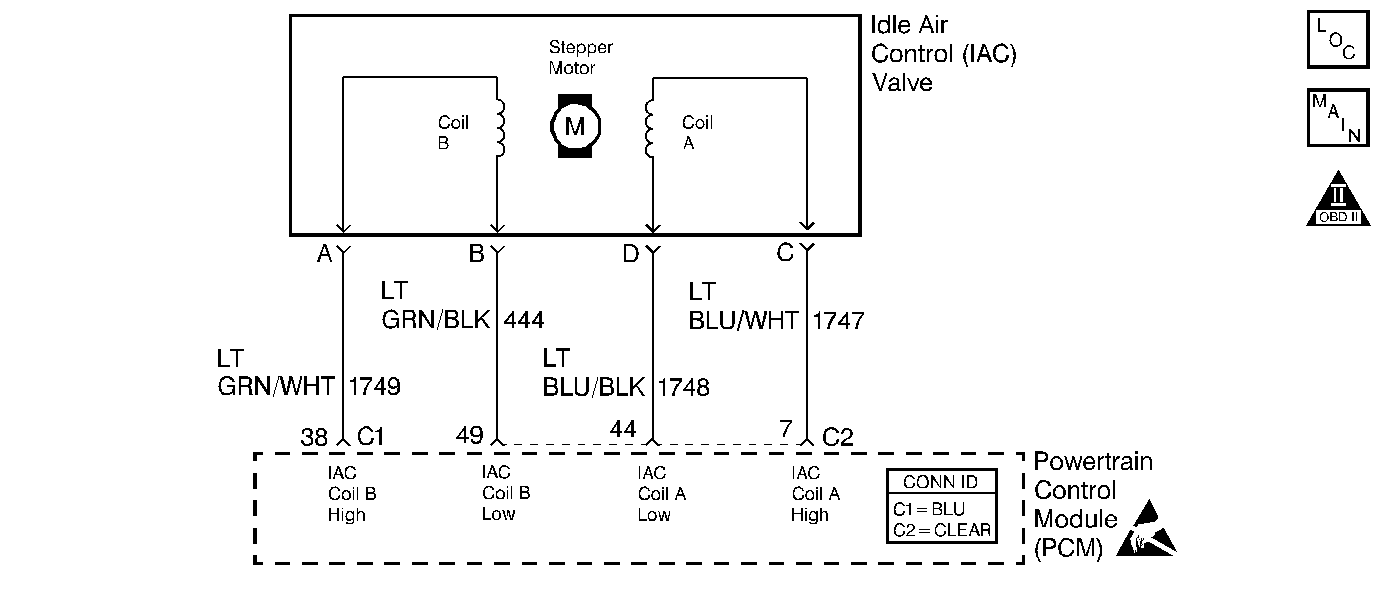
Circuit Description
The PCM controls the air entering into the engine with an Idle Control (IAC) valve. In order to increase the idle rpm, the PCM commands the pintle inside the IAC valve away from the throttle body seat. This allows more air to bypass through the throttle blade. In order to decrease the rpm the PCM commands the pintle towards the throttle body seat. This reduces the amount of air bypassing the throttle blade. A scan tool will read the IAC valve pintle position in counts. The higher the counts, the more air that is allowed to bypass the throttle blade.
Conditions for Running the DTC
| • | No active TP, ECT, MAP, IAT, MAF, CKP, sensor, EVAP, misfire, EGR, VSS, Fuel Trim, injector circuit, DTCs active. |
| • | Engine Coolant Temperature is above 70°C (158°F). |
| • | The engine has been running for at least 2 minutes. |
| • | System voltage is between 9.0-16.0 volts. |
| • | Vehicle Speed is less than 3 mph. |
| • | Intake Air Temperature is above -18°C (0°F). |
| • | The throttle is closed |
| • | BARO above 65 kPa. |
| • | Engine run time is greater than 2 minutes. |
Conditions for Setting the DTC
| • | The IAC valve reads less than 15 counts on the scan tool. |
| • | Engine Speed is more than 100 RPM higher than Desired Idle. |
Action Taken When the DTC Sets
| • | The PCM will illuminate the malfunction indicator lamp (MIL) during the second consecutive trip in which the diagnostic test has been run and failed. |
| • | The PCM will store conditions which were present when the DTC set as Freeze Frame and Failure Records data. |
Conditions for Clearing the MIL/DTC
| • | The PCM will turn OFF the MIL during the third consecutive trip in which the diagnostic has been run and passed. |
| • | The History DTC will clear after 40 consecutive warm-up cycles have occurred without a malfunction. |
| • | The DTC can be cleared by using the scan tool. |
Diagnostic Aids
Check for the following conditions:
| • | Poor connection at PCM or IAC motor. Inspect harness connectors for backed out terminals, improper mating, broken locks, improperly formed or damaged terminals, and poor terminal to wire connection. Refer to Intermittents and Poor Connections Diagnosis and Connector Repairs . |
| • | Damaged harness. Inspect the wiring harness for damage. Refer to Wiring Repairs . |
| • | Restricted air intake system. Check for a possible collapsed air intake duct, restricted air filter element, or foreign objects blocking the air intake system. |
| • | Throttle body. Check for objects blocking the IAC passage or throttle bore, excessive deposits in the IAC passage and on the IAC pintle, and excessive deposits in the throttle bore and on the throttle plate. |
| • | Large vacuum leak. Check for a condition that causes a large vacuum leak, such as a incorrectly installed or faulty PCV valve or brake booster hose disconnected. |
Reviewing the Fail Records vehicle mileage since the diagnostic test last failed may help determine how often the condition that caused the DTC to be set occurs. This may assist in diagnosing the condition.
Test Description
The numbers below refer to the step numbers on the diagnostic table:
Step | Action | Value(s) | Yes | No | ||||||||
|---|---|---|---|---|---|---|---|---|---|---|---|---|
1 | Was the Powertrain on-Board Diagnostic (OBD) System Check performed? | -- | ||||||||||
2 | Are anyh other DTCs set? | -- | Got to applicable DTC | |||||||||
3 |
Does Engine Speed remain within the specified value of Desired Idle for each RPM commanded | 50 RPM | Go to Diagnostic Aids | |||||||||
4 |
Does the node light cycle from red to green (never off)? | -- | ||||||||||
5 |
Was a problem found? | -- | ||||||||||
6 |
| -- | Go to appropriate section for on vehicle service | |||||||||
7 |
Was a problem found? | -- | ||||||||||
8 | Replace the IAC Valve. Refer to Idle Air Control Valve Replacement . Is the action complete? | -- | -- | |||||||||
9 |
Was a problem found? | -- | ||||||||||
|
Important: : Replacement PCM must be programmed. Refer to Powertrain Control Module Replacement/Programming . Replace the PCM. Is the action complete? | -- | -- | ||||||||||
11 |
Does the Engine Speed remain within the specified value of Desired Idle for each RPM commanded | 50 RPM | System OK |
